#pattachitra
Photo

Ganesha with Six Armes
Pattachitra Painting on Tussar silk
(via Twitter: Pattachitra Paintings Of Odisha @Pattachitrap)
338 notes
·
View notes
Text

New Balance Made In England 991 “Shy Pink”
Available HERE for purchase on grailed
41 notes
·
View notes
Photo
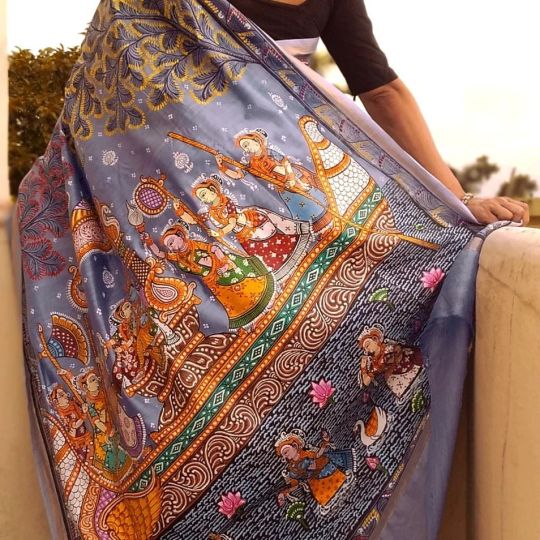
Festivity Calls for Celebration of Tradition & Heritage in Style & Grandeur.. In Tune with Tradition this Puja Celebrate with distinct art od Odishi Pattachitra that revolve around Lord Jagannath at Puri's famous Jagannath Temple. This hand painted Tussar by Modal Silk Saree By the skilled artisans of Odisha in " NAUKA RAAS / VIHAR " will certainly add a traditional touch to your festive dressing and brighten up your Durga Puja / Navaratri Days & Nights. DESCRIPTION : This painting depicts a scene of Nauka Vihar Of Lord Krishna performing Rasa Leela with Radha and other Gopis. Rasa means 'aesthetics','nectar', 'emotion' or 'sweet taste' and leela means 'act', 'play' or 'dance', which translates to 'a play of sweet Love'. The base of the saree is Steel Blue with Multi colour artwork all over it,the pallu of the saree depicts " Nauka Vihar of Radha Krishna with Gopinis" painted with beautiful intricate lines. Through bright Colors we see Lord Krishna seated in a boat with his sweetheart ,Radha and other Gopikas while two of them look on from the banks. The lotus spangled lake and budding trees in the backdrop make this boat ride a delightful experience. More than a Saree its a Canvas reflecting a Vision from a time of ultimate devotion and surrender to supreme to Love. The blouse of the saree also has beautifully done motifs in borders. Product Specification Length – 6.3 Mtrs Wrap*weft (Tana*Bana) – 4Ply Silk*Silk Fabric – Tussar by Modal Silk Blouse Piece – Yes Color hues may vary from that which appears in the image Livelihood Purchasing this product would render 28 Days of livelihood. SPECIAL INSTRUCTIONS - Suggested dry cleaning - Please Do not squeeze or wring - Store in clean, dry place away from Insects, dust, excessive light and moisture. #pattachitra#painting #artist #pattachitrapainting #indianart #pattachitraart #odisha #krishnaleela #handmade #traditionalart #krishnalove #artistsoninstagram #india #ig #instagood #artwork #hinduism #instaart #artistoninstagram #indianfolkart #indianartist #krishna #hindu #traditional #projectrangamaati #rangamaati #artisan (at Kolkata - The City of Joy) https://www.instagram.com/p/CiVKxDgoswI/?igshid=NGJjMDIxMWI=
#pattachitra#painting#artist#pattachitrapainting#indianart#pattachitraart#odisha#krishnaleela#handmade#traditionalart#krishnalove#artistsoninstagram#india#ig#instagood#artwork#hinduism#instaart#artistoninstagram#indianfolkart#indianartist#krishna#hindu#traditional#projectrangamaati#rangamaati#artisan
2 notes
·
View notes
Text

Set of 6, Grande gift set includes:
1) 2 Perfume Roll On (8ml)
Blossom Perfume Roll On (Notes: Floral, Fruity and Feminine)
Sky Perfume Roll On (Notes: Fresh, Floral, Citric)
2) Kewda Essential Oil
3) Pattachitra Painting
4) Kesar Incense Stick (Notes: Warm, Earthy, Strong)
5) Post card
#raw agarbatti#rakshabandhan gift for sister#raksha bandhan gift for sister#raksha bandhan gift#pattachitra painting#pattachitra art#pattachitra#patachitra painting#patachitra#incense sticks#incense stick#gifts for women#gifts for sister#gifts for raksha bandhan#gift ideas for women#gift ideas#gift box#gift#essentialoil#essential oil diffuser#Diffusere#diffuser oil#Diffuser#agarbattis#agarbatti#handmade#art#crafts#health & fitness#home decor
3 notes
·
View notes
Text

instagram
4 notes
·
View notes
Text

https://diy.penkraft.in/ProductDetails/Pattachitra-Art-on-MDF-Tray-with-Square-Tea-Coasters-DIY-Kit-by-Penkraft
• 1 MDF Square Tray (8"X8") and 2 Square Coasters (4"X4")
• Acrylic Colors -set of 6
• Brush No. 000 and 3 (one each)
• Stencil on tracing paper
• Free Video Tutorial
0 notes
Text

Dhokra necklaces are known for their intricate designs, often featuring simple and organic shapes such as leaves, flowers and animals. Our dhokra necklaces are known for their unique and handcrafted look. Beautiful accessories are often passed down from generation.https://charutadesigns.com/collection/Dhokra
0 notes
Text
PATTACHITRA OF ODISHA
PATTACHITRA OF ODISHA
Pattachitra style of painting is one of the oldest and most popular art forms of Odisha. The name
Pattachitra has evolved from the Sanskrit words patta, meaning canvas, and chitra, meaning picture.
Pattachitra is thus a painting done on canvas, and is manifested by rich colourful application, creative
motifs and designs, and portrayal of simple themes, mostly mythological in depiction.
PATTACHITRA AVAILABLE
Some of the popular themes represented through this art form are Thia Badhia – depiction of the temple of
Jagannath; Krishna Lila – enactment of Jagannath as Lord Krishna displaying his powers as a child; Dasabatara
Patti – the ten incarnations of Lord Vishnu; Panchamukhi – depiction of Lord Ganesh as a five-headed deity.
More than anything, the themes are clearly the essence of the art form, conceptualising the meaning of the
paintings. It is no surprise therefore that the process of preparing the paintings engages undeterred concentration
and careful craftsmanship, stretching the preparation time of the patta alone to around five days.
Making the patta is the first thing that comes in the agenda, and the painters, also called chitrakars, go about
their work in preparing a tamarind paste, which is made by soaking tamarind seeds in water for three days. The seeds
are later pounded with a crusher, mixed with water, and heated in an earthen pot to turn it to a paste, which is
called niryas kalpa. The paste is then used to hold two pieces of cloth together with it, and coated with a powder
of soft clay stone a couple of times till it becomes firm. Soon as the cloth becomes dry, the final touch of polishing
it with a rough stone and then a smooth stone or wood is given, until the surface becomes smooth and leathery, and is
all ready as a canvas to be painted on.
Preparing the paints is perhaps the most important part of the creation of Pattachitra, engaging the craftsmanship of the
chitrakars in using naturally available raw materials to bring about indigenous paints. The gum of the kaitha tree is the
chief ingredient, and is used as a base for making different pigments, on which diverse raw materials are mixed for diverse
colours. Powdered conch shells, for instance, are used for making a white pigment, while lamp soot is used for a black pigment.
The root of the keya plant is usually used for making the common brush, while mouse hair is used on the requirement of finer
brushes, to be attached to wooden handles.
The creation of the Pattachitra paintings is a disciplined art form, and the chitrakars maintain rigidity in their use of colours
and patterns, restricting the colours to a single tone. Limiting themselves within the boundaries of some rules, the chitrakars
come up with such remarkable paintings depicting stark emotional expressions that it is a surprise shading of colours is a taboo.
In fact, it is this display of emotions of the figures expressed in the paintings, which is the crème de la crème of the art form,
and the chitrakars put in their best to bring out the most through their rich colourful motifs.
With the passage of time, the art of Pattachitra has gone through a commendable transition, and the chitrakars have painted on
tussar silk and palm leaves, and even created wall hangings and showpieces. However, this kind of innovativeness has never proved
to be a hindrance in their customary depiction of figures and the use of colours, which has remained intact throughout generations.
This constancy is the key factor that has maintained the effervescence of Pattachitra, backed with the fact that the setting up of
some special centres for the art form in Odisha speaks volumes for its popularity.
0 notes
Text
Pattachitra: An Ancient Folk Art that Reflects the Ethos of India
Traditional arts are an important part of the culture, where skills and knowledge are passed down from one generation to the next. It is transmitted orally and by following in the footsteps of a cultural group.
Leaf painting is important in Oriya painting, which developed in the Jagannath temple of Puri in the 12th century. The Jagannath Temple has been the centre of art and culture in Odisha.
Puri and Raghurajpur are famous for their myths, deities and folklore associated with Pattachitra. This art flourished under the support of the Ganga kings and the Bhoi dynasty. These paintings aimed to popularise Jagannath's worship among the millions of pilgrims visiting Puri.

The origins of Pattachitra painting can be traced back to the 8th century AD, making it one of the earliest forms of indigenous painting. The word "Pattachitra" comes from the Sanskrit words "Patta", meaning canvas, and "Chitra", meaning painting. Thus, Pattachitra involves creating canvas paintings that depict vibrant colours, unique motifs and designs and often mythological themes.
Most of these paintings depict stories of Hindu gods and goddesses. Pattachitra art refers to the ancient frescoes found in sacred centres such as Puri, Konark and Bhubaneswar in Odisha, which date back to the 5th century BC. Fine examples of this art can be seen in and around Puri, especially in the villages of Raghurajpur and Dandsahi.
Different Styles of Pattachitra Paintings
Pata paintings come in a variety of styles, including paintings of Jagannath, the Holy Trinity, and paintings of their chariots. Pattachitra is based on Ramayana, Mahabharata, Bhagavad Gita and various Puranas and Kavyas. Pattachitras of folktales and animal-bird stories, as well as erotic pattachitras.
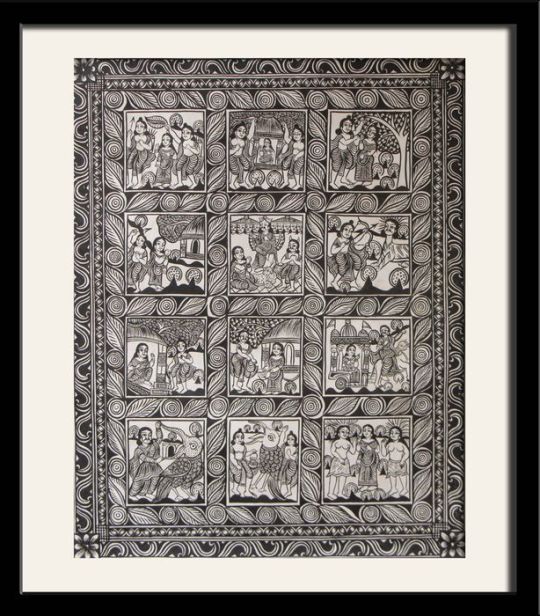
Process of Making Pattachitra Paintings
To begin with, the folk painter chooses two pieces of cloth and sticks them together using a paste made from tamarind seeds. Tamarind seeds are soaked in water for a few days till they swell and become soft. Then, they are pounded with a pestle to make a thick paste. A little water and the ingredients are added to an earthen pot, and the mixture is cooked to make a fine paste. This glue is used to bind two fabrics together, forming a bandage.
The colours used in folk artworks are made from natural elements found in India. Some examples include porcelain, soft clay or chalk, conch shell, red stone and yellow-brown ocher. For the white colour, the artists use shells found in abundance on the beaches of Orissa. Folk women make folium by placing the oiled leaves on a burning flame, which creates a black colour. Gum is added to the juice of green leaves to make the green colour. Red and yellow colours are made by grinding red and ocher stones and making their paste. The blue colour is obtained from a blue stone called Rajbarta. These colours also symbolize the essence of each character depicted in the painting. White represents "laughter" (Hasama), red represents "anger" (Raudra), and yellow represents "awe" (Adhibhuta).
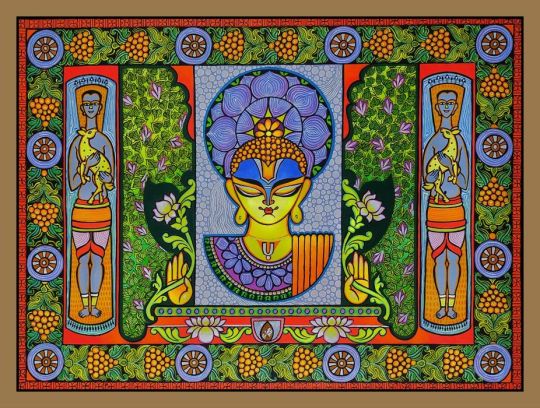
In making patas paintings, traditional artists use five primary colours. These natural colours are associated with the divine colours of Jagannath, Balabhadra, Subhadra, Sihasana and Neela Chakra, recognized by Orissa's folk painters and sages. These are collectively called the Pancha Tattva, which means the five components.
Pattachitra painting requires a floral border with intricate designs and leaves, as the Chitra highlights the folklore and story. The lines are bold, crisp and sharp. In general, there is no landscape, perspective or distant view here. All events are shown adjacent to each other. The Pattachitra style combines folk and classical influences.
With time, a significant change has been observed in Pattachitra art, and painters have started painting on palm leaves and Tussar silk.
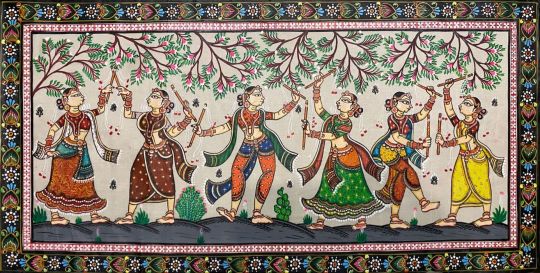
Pattachitra paintings are not limited to cloth only; Setting up palm leaves or silk. It is practised on sarees, purses, wall hangings and even showpieces. These scroll paintings are not confined to South India but spread to western parts of India and Western countries. Under the leadership of the American Friends Service Committee, an exhibition was organized at Puri Town Hall in 1953, and two shows were held in Delhi and Calcutta in 1954. Shri Nabakrishna Chowdhary, the then Chief Minister of Orissa, worked hard to revive the indigenous art form of Orissa.
1 note
·
View note
Photo
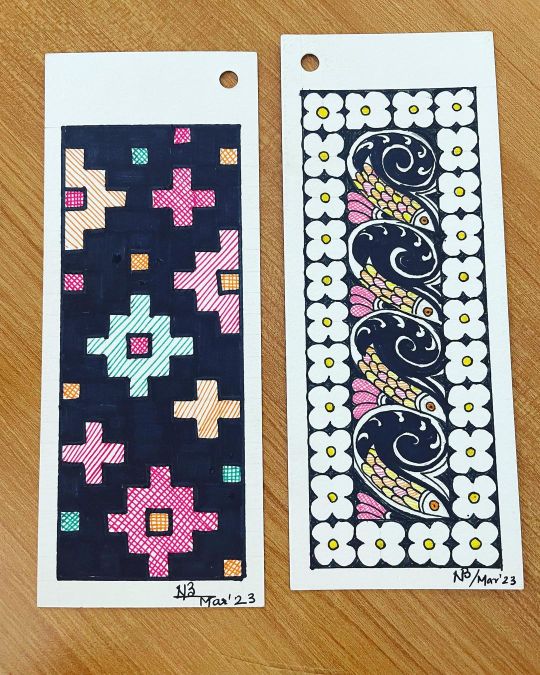
#bookmarks #bookstagram #pattachitra #veeralipattu #artist #artistsoninstagram https://www.instagram.com/p/CqXoz3gvJ44/?igshid=NGJjMDIxMWI=
0 notes
Photo
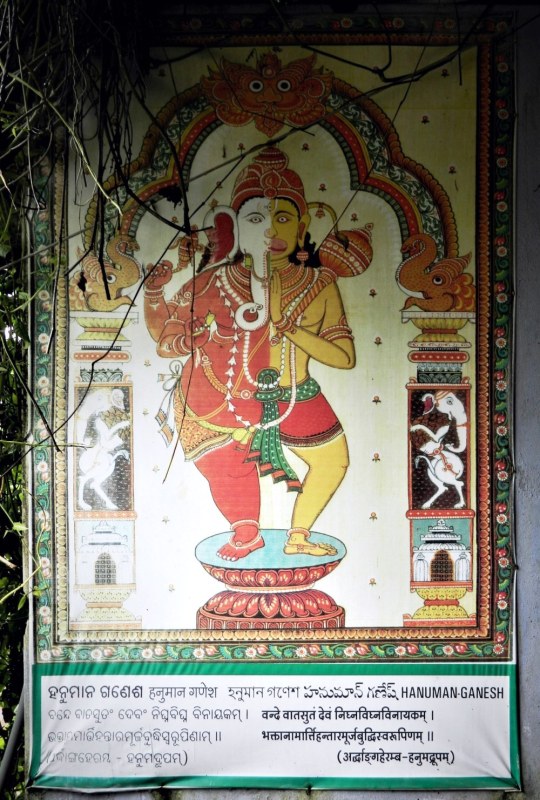
Ganesha Hanuman at Jagannath Temple, Koraput, Odisha
🇮🇳 @SharanMishra wrote :
ବନ୍ଦେ ବାତସୁତଂ ଦେବଂ ନିଘ୍ନବିଘ୍ନ ବିନାୟକମ୍।
ଭକ୍ତାନାମାର୍ତ୍ତିହନ୍ତାରମୂର୍ଜବୁଦ୍ଧିସ୍ୱରୁପିଣାମ୍।।
(ଅର୍ଦ୍ଧାଙ୍ଗହେରମ୍ବ ହନୁମଦ୍ରୁପମ)
वन्दे वातसुतं देवं निघ्नविघ्नविनायकम्।
भक्तानामार्तिहन्तारमूर्जबुद्धिस्वरूपिणम्।।
(अधाङ्गहेरम्ब हनुमद्रूपम्)
(via Twitter: 🇮🇳 @SharanMishra)
105 notes
·
View notes
Text
Maa Saraswati with Tree of Life Pattachitra Painting

The Maa Saraswati with Tree of Life Pattachitra Painting is a traditional Indian folk art style painting that depicts the Hindu goddess of knowledge, music, and arts, Maa Saraswati. In this painting, she is depicted seated on a lotus flower surrounded by a tree of life, symbolizing growth, prosperity, and knowledge. The painting is done on cloth using natural pigments, and the intricate details and vibrant colors of the painting are a testament to the skill and expertise of the Pattachitra artist.
This beautiful and vibrant piece of art is not only a visual treat, but also serves as a symbol of the goddess's blessings for knowledge, creativity, and success in one's pursuits.
To get this beautiful Pattachitra painting visit: https://sabhyasha.com/maa-saraswati-tree-of-life-pattachitra/
You can also call us at +91 8926273115
For more information visit us:
Facebook: https://www.facebook.com/sabhyasha »
Instagram: https://www.instagram.com/sabhyasha_art/ »
Pinterest: https://in.pinterest.com/sabhyashastore/ »
LinkedIn: https://www.linkedin.com/company/sabhyasha/ »
0 notes
Text

• 1 Canvas Board (8"X8")
• Acrylic Colors Set of 6
• Brush No. 000 and 3 (One each)
• Stencil on tracing paper
• Free Video Tutorial
#artwork#artsy#artforms#creativity#artoftheday#diykits#diy#penkraft#pattachitra#pattachitraart#canvas
0 notes
Text
#PenkraftCourses#PenkraftOnline#OnlineCourses#Pattachitra#Art#HobbyIdeas#OnlineHobby#Creativity#COVID19#AtmanirbharBharat
1 note
·
View note
Photo

Fesitivity Calls for Celebration of Tradition & Heritage in Style & Grandeur. This hand painted Tussar by Modal Silk Saree by the skilled artisans of Odisha in " YAMUNA PAAR RAAS LEELA " will certainly add a traditional touch to your festive dressing and brighten up your Durga Puja / Navaratri Days & Nights. DESCRIPTION : This painting depicts a scene of " YAMUNA PAAR RAAS LEELA " (Divine love affair) of Lord Krishna with Radhika and Gopikas. Recall of this theme in sight brings love n wellbeing in the environment. The base of the saree is plum Tone with Multi colour artwork all over it,the pallu of the saree depicts" YAMUNA PAAR RAAS LEELA " of Radha Krishna with Gopinis" painted with beautiful intricate lines. Through bright Colors we see Lord Krishna promising the Gopis a Safe passge to the other side of Yamuna River in his boat with his sweetheart Radha and other gopikas while two of them look on from the banks. The lotus spangled lake and budding trees in the backdrop make this boat ride a delightful experience. More than a Saree its a Canvas reflecting a Vision from a time beyond. The blouse of the saree also has beautifully done motifs in borders. Product Specification Length – 6.3 Mtrs Wrap*weft (Tana*Bana) – 4Ply Tussar Silk*Modfal Silk Fabric–Tussar by ModalSilk. Blouse Piece – Yes Color Shade : Plum Color hues may vary from that which appears in the image Livelihood : Purchasing this product would render 18 Days of livelihood. SPECIAL INSTRUCTIONS - Suggested dry cleaning - Please Do not squeeze or wring. - Store in clean, dry place away from insects, dust, excessive light and moisture. #pattachitra#painting #artist #pattachitrapainting #indianart #pattachitraart #odisha #krishnaleela #handmade #traditionalart #krishnalove #artistsoninstagram #india #indianfolkart #indianartist #krishna #hindu #traditional #projectrangamaati #rangamaati #artisan #handmade #art #handcrafted #artisanat #artist #smallbusiness #madeinindia (at Kolkata - The City of Joy) https://www.instagram.com/p/CifYcJpvhqG/?igshid=NGJjMDIxMWI=
#pattachitra#painting#artist#pattachitrapainting#indianart#pattachitraart#odisha#krishnaleela#handmade#traditionalart#krishnalove#artistsoninstagram#india#indianfolkart#indianartist#krishna#hindu#traditional#projectrangamaati#rangamaati#artisan#art#handcrafted#artisanat#smallbusiness#madeinindia
0 notes
